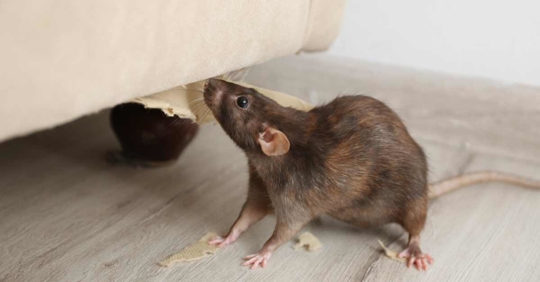As the crisp autumn air sweeps through Chicago, bringing cozy sweaters and pumpkin spice with it, it also ushers in an unwelcome guest for many homeowners: rodents. These cunning critters, seeking warmth, food, and shelter, often see your home as the perfect winter getaway. But how can you tell if you’ve got a rodent problem brewing before it becomes a full-blown infestation? Recognizing the early warning signs is key to protecting your home and family from the health risks and damage these pests can cause.
Don't let fall bring unwanted guests! If you're seeing signs of rodents, act fast. Contact Aerex Pest Control for professional and effective rodent control solutions designed for Chicago homeowners.
Understanding Why Rodents Seek Shelter in the Fall
Before diving into the signs, it's helpful to understand why fall is prime time for rodent invasions. As temperatures drop and outdoor food sources become scarcer, mice and rats naturally look for more hospitable environments. Your warm, well-stocked Chicago home offers everything they need to survive the colder months.
They can squeeze through surprisingly small openings, making their way into basements, attics, walls, and even living spaces. Once inside, they can multiply rapidly, turning a small nuisance into a significant problem in a short amount of time.
Unmistakable Clues: The Obvious Signs of Rodent Activity
Sometimes, the signs are right in front of you. Being aware of these obvious indicators can help you identify a rodent problem early.
Droppings
This is often the most common and undeniable sign of rodents. Mouse droppings are small, pellet-like, and dark, resembling grains of rice, while rat droppings are larger, about the size of a raisin. You'll typically find them along walls, in cupboards, under sinks, in attics, or near food sources. The fresher the droppings, the more active the infestation.
Gnaw Marks
Rodents have a constant need to chew to keep their incisors from growing too long. You might notice gnaw marks on food packaging, wooden furniture, electrical wires, pipes, or even structural elements of your home. These marks can vary in size depending on whether you have mice or rats, but they are a clear indication of rodent presence. Chewed electrical wires, in particular, pose a significant fire hazard.
Nesting Materials
Mice and rats will build nests in secluded, warm areas using shredded materials like insulation, fabric, paper, or even dryer lint. Check hidden spots like attics, basements, wall voids, or behind appliances for these makeshift nests. The presence of nesting materials suggests a well-established and comfortable rodent population.
Unusual Noises
At night, when your home is quietest, you might hear scratching, scurrying, or gnawing sounds coming from your walls, ceiling, or attic. These sounds are often the tell-tale sign of rodents moving around, foraging for food, or building their nests. While subtle at first, these noises can become more pronounced as the infestation grows.
Subtle Hints: Less Obvious Indicators of a Rodent Issue
Not all signs are as overt as droppings or gnaw marks. Sometimes, you need to be a bit more observant to catch the subtle hints rodents leave behind. Here are some of the less obvious but equally important signs to look for:
Grease Marks or Smudge Marks
As rodents travel repeatedly along pathways, the oils and dirt from their fur can leave dark, greasy marks on walls, baseboards, and pipes. These "runways" are often found in tight spaces or along frequently used routes between their nest and food sources.
Unpleasant Odors
A persistent, musky odor can be a strong indicator of a rodent infestation. This smell comes from their urine and droppings, and it can become quite noticeable, especially in enclosed areas like pantries or cabinets, or near active nesting sites. The smell often intensifies as the infestation grows.
Agitated Pets
Your pets, especially dogs and cats, have a heightened sense of smell and hearing. If your pet becomes unusually agitated, staring intently at walls, scratching at areas, or barking at seemingly nothing, they might be sensing rodents that you can't yet detect. Their behavior can be an early warning system.
Holes or Gaps
Rodents can squeeze through incredibly small openings. A mouse can get through a hole the size of a dime, and a rat through a hole the size of a quarter. Regularly inspect your home's exterior for new cracks in the foundation, gaps around utility lines, or openings around windows and doors. Even small gaps can be an invitation for these pests.
What to Do When You Spot the Signs
If you observe any of the above signs, it's important to address the issue promptly to avoid more extensive damage or health risks.
- Inspect your home thoroughly: Check common entry points such as gaps around doors, windows, vents, and utility lines.
- Remove food sources: Store food in sealed containers and keep countertops clean.
- Seal entry points: Use steel wool or caulking to block holes and cracks.
- Monitor for activity: Set up traps or use motion-activated cameras if necessary.
However, managing rodents can be challenging without the right tools and expertise. For immediate help, trust Aerex Pest Control’s professional rodent control team to evaluate your home and provide a targeted plan. We use methods tailored to the Chicago climate and local rodent species to effectively manage and reduce risks.
Don’t let rodents take over your home this fall. Reach out to us today through our online contact form or call us at (847) 255-8888 for expert pest control you can rely on.

